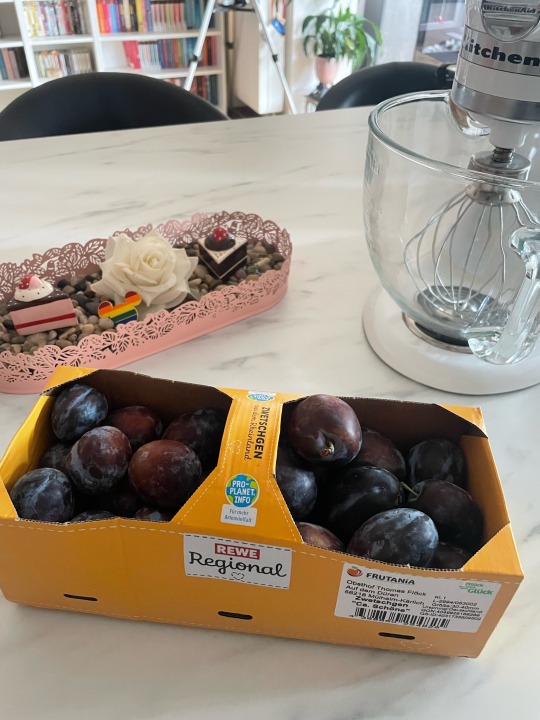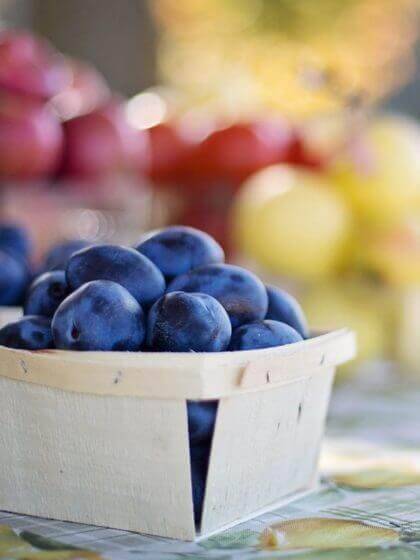#zwetschgen
Explore tagged Tumblr posts
Photo

Selbst gebackener und fermentierter Zwetschgenkuchen 🥧 dieser leckere Kuchen wurde zwei Tage lang fermentiert. #foodfotografie #Zwetschgenkuchen #pflaumenkuchen #fermentieren #Backen #Pflaumen #Zwetschgen #Kuchen #Hefeteig #fermentierterhefeteig #Baking #plumcake (hier: Nack) https://www.instagram.com/p/CpQXfJgs8bX/?igshid=NGJjMDIxMWI=
#foodfotografie#zwetschgenkuchen#pflaumenkuchen#fermentieren#backen#pflaumen#zwetschgen#kuchen#hefeteig#fermentierterhefeteig#baking#plumcake
3 notes
·
View notes
Text
Zwetschgenkuchen mit Schmand-Guss
#Zwetschgen #Mürbeteig #Schmandguss #Waie
#Food#Mübeteig#plums#Rezept#saftig#Sauerrahm#Schmand#Schmandguss#Sour Cream#Waie#Zimt#Zweschgewaie#Zwetschgen
0 notes
Text
Z wie Zwetschge – Fünfundreissigster 2024 – P For Plums
Auf der Südseite unseres Hauses stehen ein paar Obstbäume mehr schlecht als recht. Und doch lese ich jedes Jahr viele Äpfel auf, von denen die meisten von Nachbars Kühen zum Dessert verspiesen werden. Die schönsten Exemplare esse ich in Schnitzen, backe sie zu Kuchen oder verkoche sie zu Apfelmus. Ein Aufruf im Whutsup-Status führte ein paar Abnehmerinnen zu mir. Alle fünf Jahre werden auch…

View On WordPress
0 notes
Text


1 note
·
View note
Text
Brathuhn, Saucenkartoffel, Zwetschgenrotkohl
Wir würzen mit Salz, Pfeffer, etwas Zucker (beim Anbraten), etwas Rosmarinpulver. Das Brathuhn wird recht streng angebraten, bis der Zucker – Colore zeigt. Mit wenig Wasser ablöschen. Geschälte, neue, in Stücke geschnittene Kartoffeln dazu geben, abdecken und 15 Minuten, nach dem Aufkochen, auf Stufe 2 – Induktion einstellen. Backpflaumen in Nelken, Zimt, Zuckerwasser und etws Kartoffelstärke…

View On WordPress
0 notes
Text
It is once again time for us to be absolutely drowning in neighborly prune plums. Anyone got good recipes?
0 notes
Text
Es is vielleicht alles grad nich so leicht aber immerhin is pflaumensaison. Immerhin is pflaumensaison
#german stuff#deutsches zeug#so ich gönn mir jetzt n stück pflaumenkuchen#Zwetschgendatschi#whateverrrrrrr#eine internetsuche später: zwetschgen sind ne pflaumen-unterart#so
211 notes
·
View notes
Text

All right, Christmas hour is over, summer baking is about to happen 😂
#Zwetschgen Kuchen my beloved#I only ever make you once because cutting 1.5kg of plums is a pain#but I love you
2 notes
·
View notes
Photo

4 köstliche Rezeptideen mit Pflaumen und Zwetschgen
Ob nun Zwetschge oder Pflaume, das Steinobst hat im Sommer Saison und du darfst dich auf köstliche Kreationen freuen. Hier 4 Rezeptideen für Dich!
0 notes
Text

https://pane-bistecca.com/2023/09/13/andreas-glutenfreie-apfel-zwetschgen-wahe/
#food#pie#waehe#fruechte#fruits#apples#aepfel#plums#prunes#zwetschgen#marzipan#glutenfrei#glutenfree#backen#baking#guest entry#gastbeitrag
0 notes
Text
28.8.2024 | Käferberg | 19.30h
Im Wasserloch zwei Frösche, viele Mücken, Zwetschgen.
2 notes
·
View notes
Text

Ok, another "biggie" - this time on German Jewish life from the Enlightenment to the rise of Nazi rule.
The German Enlightenment began around 1650 when Germany was a group of absolutist kingdoms (Prussia, Hamburg, Bradenburg, Pomerania, etc.)
The rulers of these kingdoms realized it was not economically feasible to constantly expel their Jews, who had proven to be a valuable “commodity” wherever they were tolerated.
So, the expulsions slowed, but anti-Jewish attacks remained.
One infamous German mob attack took place in 1699 against the Jewish Quarter of Bamberg. As the mob attacked, one Jew poured a basket of ripe plums on top of them. For some reason, this caused panic among the rioters, who fled. This bizarre event is still commemorated every 29th of Nisan as the Zwetschgen-Ta’anit (“Prune-Fest”).
The 1700s in Germany saw the “reforms” of Frederick II, the king of Prussia (who Hitler would later call a “heroic genius”).
Frederick II felt his kingdom had “too many Jews.” But rather than expel them, he wanted them to essentially “make themselves useful” on the Polish border engaging in trade.
Beginning in 1750, Frederick II issued various anti-Jewish edicts aimed at keeping the Jewish population to an absolute, fixed minimum. He named a small number of “protected” Jewish families who could stay in specific cities provided they abstain from future marriages lest they "transform it into complete Jerusalem."
In the 1760s, Frederick II also issued edicts precluding Jews from various occupations. Then came the oppressive taxation. Frederick II would not permit Jews to fight in the Seven Years War – instead, he required Jews to pay extraordinary sums to fund his war while keeping the Jewish community poor.
Decades after Frederick II, however, in 1812, Prussia became the first German state to grant citizenship to its Jews.
However, the problem of the European “Enlightenment” was that “full rights” for Jews came with the condition that they discard all that made them Jewish. In other words, you could be accepted as a German citizen or you could choose to remain a Jew. You couldn’t be both.
Of note, 1812 was also the year the Brothers Grimm published Rumpelstiltskin. This treasured fairy tale along with various others by the Brothers Grimm, including Little Red Riding Hood and Hansel and Gretel are loaded with thinly-veiled antisemitism. Other works by the Brothers Grimm were not so subtle. Antisemitism was the express theme of their stories The Jew in the Brambles, The Jew Among the Thorns, and The Good Bargain.
In fact, in Nazi Germany, all German households were required to own a copy of the “sacred” Brothers Grimm tales, and schools were required to use their antisemitic stories as educational literature.
1817 saw the rise of the Reform Judaism movement, which was intended both to "modernize" Judaism and make it palatable to German Christians.
Some German Christians, however, were not impressed by these assimilation attempts.
Have you ever said the words, “hep hep hooray?” Well, I’m sorry to tell you that phrase has antisemitic origins.
During the series of “Hep Hep” riots in 1819, violent anti-Jewish mobs used “Hep Hep” as their rallying cry. The term had a double meaning. It was an acronym for the Latin phrase “Hierosolyma est perdita” meaning “Jerusalem is lost” and said to taunt Prussian Jews. It was also what German sheep-herders yelped to their sheep to keep them in order. Basically, the phrase came naturally to Prussians who hated Jews, and it was even used more than 100 years later by Hitler’s stormtroopers when they went on the prowl for Jews.
Despite widespread antisemitism, the bilateral efforts of German Enlightenment thinkers and Jewish assimilationists led ultimately to the Revolution of 1848, when all German states proclaimed Jewish emancipation.
Again, however, any gains by the German Jewish community were always met with antisemitic backlash.
One of Germany’s most famous composers, Richard Wagner, was a virulent antisemite and one of Hitler's inspirations.
In 1850, Wagner began speaking out against what he called “Jewish decadence” and influence in music. Wagner was one of the original faces of racist antisemitism in Germany such that “Jewish blood” was all that mattered for that person to be worthy of scorn and to be considered "dangerous" to "pure" German blood.
Wagner would later write, “I hold the Jewish race to be the born enemy of pure humanity and everything noble in it. It is certain that it is running us Germans to the ground.”
On November 1, 1867, all remaining restrictions on Jews’ right of residence, real estate purchase, and choice of profession were abolished in the North German Confederation.
A gain for the Jewish community? Yup. So, now the backlash.
Also in 1867, the German journalist Wilhelm Marr coined the phrase “antisemitism” for the purpose of being able to discuss Jew-hatred in “polite society.”
Then, in 1871, a German constitution was passed that granted Jews full equality.
Three cheers for … wait a minute.
Violent backlash against German Jews took-off again in 1881. First, a petition calling for the removal of all Jews from public life, containing 250,000 signatures, was delivered to the Reichstag (German parliament).
Then, the pan-German Austrian leader and virulent antisemite Georg Ritter von Schönerer developed a following where (tell me if this sounds familiar) he was referred to as "Führer," and he and his followers used the greeting "Heil!"
April and May of 1881 saw popular antisemitic riots against Jewish homes in Berlin.
While German antisemitism persisted, the 1890s and early 1900s gave way to Jews finally being able to actualize some of the promises of emancipation.
Germans looked down at the “barbaric” Ukranian pogroms that were occurring and thought themselves above such things now.
In fact, by 1912, 12 of the 100 members of the Reichstag were Jews.
On the eve of World War I (1914), antisemitism was all but a fringe political force. Though there remained antisemitic parties, they never received more than 4-5% of the vote. And more than 100,000 German Jews fought for their country during the Great War (12% higher than their population ratio).
At the war’s end on November 11, 1918, there were 20 million dead.
The Treaty of Versailles that ended the war placed all blame for the war on Germany and required Germany pay reparations to the Allies. This led to the collapse of the German economy, hyperinflation, depression, and mass discontent.
Hitler and his Nazi Party attempted to take advantage of the discontent via an unsuccessful coup attempt known as the Beer Hall Putsch on November 9, 1923. Hitler was arrested, but his prominence and popularity only increased, and in 1925 he published his raving antisemitic manifesto entitled Mein Kampf (My Struggle).
Meanwhile, the United States stepped in to try to save the German economy beginning with the Dawes Plan. Essentially, the United States agreed to provide Germany with loans with which it could pay reparations to France and Britain. Suddenly, the Germany economy thrived. The "roaring twenties" began to roar for Germany as well.
But, when the Great Depression hit in 1929, America was no longer willing or able to provide any aide to Germany. The payments stopped, and Germany took the most devastating hit of all from the Depression.
In this time of turmoil, the brash German nationalist Hitler, who could rouse crowds big and small and bend them to his will, began to gain wider public support. His blaming of the Jews as a singular "boogeyman" for all of Germany’s problems became a simple explanation for Germans to accept, and his vague promises to remake the great German empire brought him a wildly devoted fanbase.
German elections on September 30, 1930, saw the Nazis become the second-largest party in the Reichstag with 18% of the vote.
Another election took place on July 31, 1932, where the Nazis won more than 37% of the vote and became the largest political party in Germany (but still not a majority).
So, in early 1933, Hitler called for more elections and launched into an intensive and violent campaign pushing Nazism and pushing Hitler as a messianic figure who would "save" Germany.
Then, on February 27, 1933, the Reichstag was set on fire and burned down. Confusion, panic, and terror spread among the German public. The Nazis used the hysteria to their advantage.
Elections took place only days later on March 5, 1933, with an extremely high turnout of 89%. The Nazis remained the largest party in the Reichstag and made major gains after securing 44% of the vote. Meanwhile, another extreme right-wing, nationalist party allied with the Nazis (the DNVP) won 8% of the vote, in effect giving Hitler his majority.
On March 23, 1933, the German government passed the Enabling Act by a landslide, which granted the government dictatorial powers. Hitler now had the power to govern by decree.
Yet another election on November 12, 1933, sealed the deal with the Nazis receiving 92% of the vote. Germany was now Hitler’s country.
Captain Allen
12 notes
·
View notes
Text
i bought a kilogram of zwetschgen today does anyone wanna come over and share. mutuals i'll give out my address so quickly . i will come pick you up at the train station. you can even murder me if you really want
4 notes
·
View notes
Text
Süße Schupfnudeln mit Mohn und Zwetschgenröster
Schupfnudeln bestehen aus Kartoffelteig und sind auch als Süßspeise köstlich - etwa mit Zwetschgen und Tonkasoße.
0 notes
